Our final destination was Santa Cruz Forest Reserve, another field station operated by Project Amazonas. Santa Cruz is quite close to Iquitos on a map, but getting from one to the other requires boat rides on two rivers (Amazon and Mazan) with a cross-land mototaxi ride in between.
You reach the Santa Cruz buildings by hiking a mile or so up a muddy rainforest path from the Mazan River. Several tambos surround a grassy clearing. The center one houses the common area, where meals are served and gatherings are gathered.

Behind the tambos lies a pond that was created by damming a forest stream. The pond serves as water source for the field station, and also home for all sorts of wild animals.
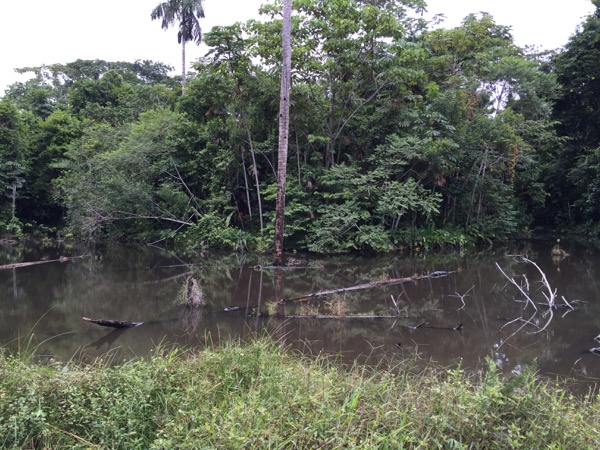
Though it's closer to the civilization of Iquitos, Santa Cruz has significantly more primary (never cut) forest than Madre Selva. Creatures that require primary forest habitat are thus considerably more likely to be found here, including every ophidiophile's favorite, the Bushmaster. I saw a Bushmaster here on my first visit, though not on my second visit. Every year or two some group visiting Santa Cruz finds a Bushmaster, so our hopes were high. However, Matt had been here eleven times (Matt can check my math here) before seeing his first Bushmaster, so our hopes were not excessively high.
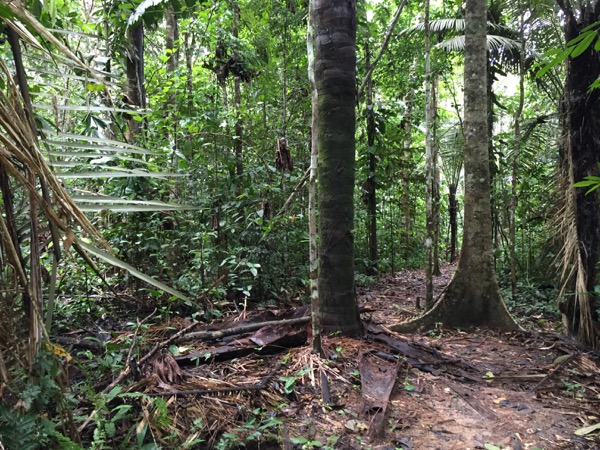
But before we discuss our viper friends any further, let's get all the bugs and frogs and lizards and such out of the way. This part will take awhile, as bugs and frogs and lizards and such are far more frequently encountered in Amazonia than snakes are.
I took a little time to deliberately photograph grasshoppers, because they are plentiful and beautiful and diverse. I also took a little time to try to identify them, but only a little. If you know more about grasshoppers than I do (which is likely), please help clarify my identifications.

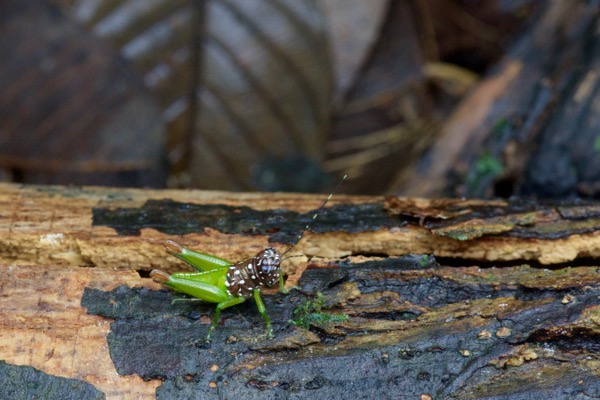
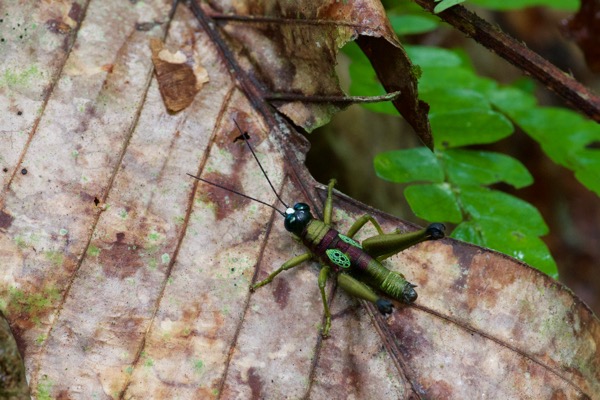
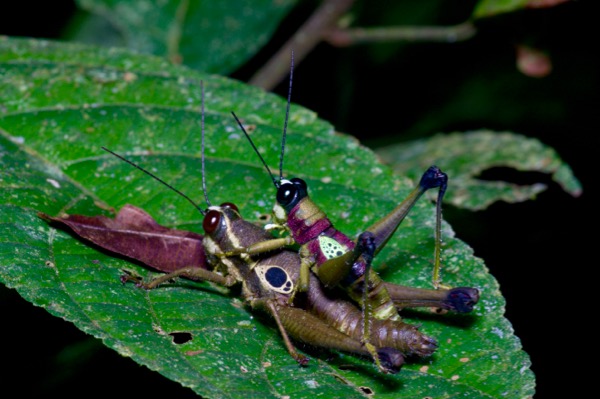
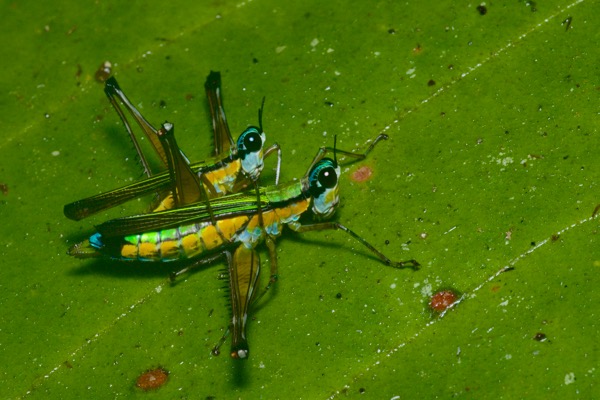
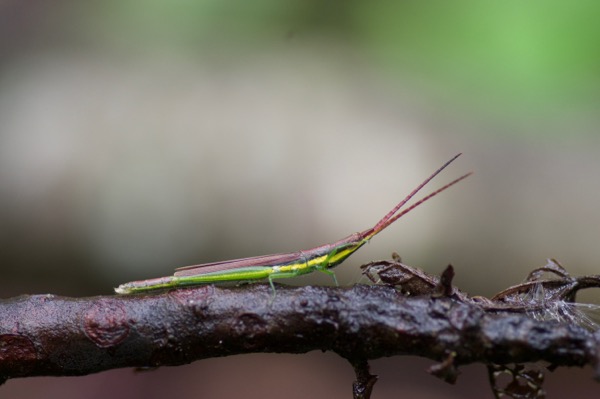
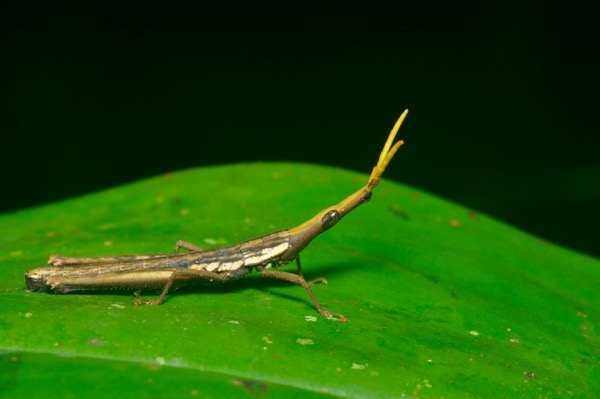
This next grasshopper was my favorite oddball, but I only got one lousy photo before it jumped and vanished. I saw it jump, and I saw it land only a few inches away, but I could not find it again; it had achieved invisibility by virtue of its fantastic camouflage.
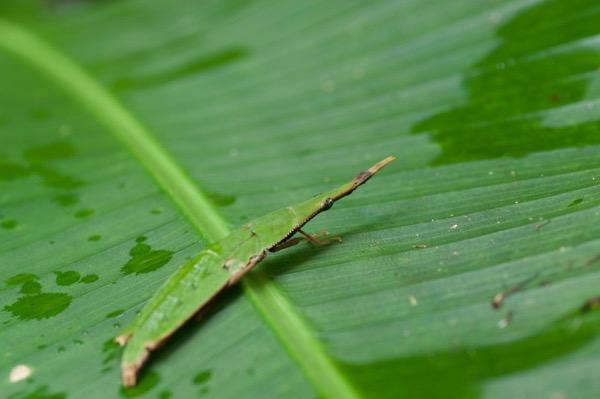
I only photographed one particularly outstanding katydid from Santa Cruz this year.
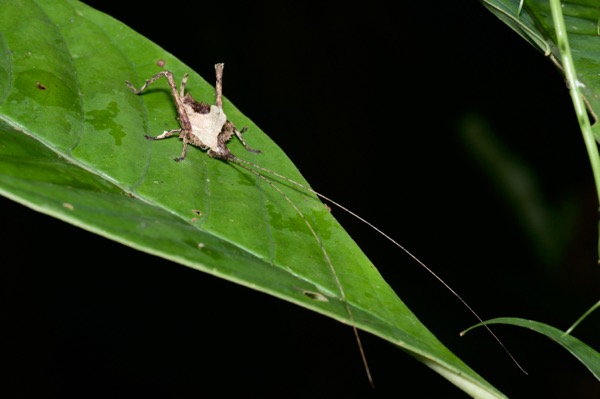
The forest was filled with beautiful and impressive butterflies and moths, but I only got photos of a few due to my strong lack of patience and only moderate interest.

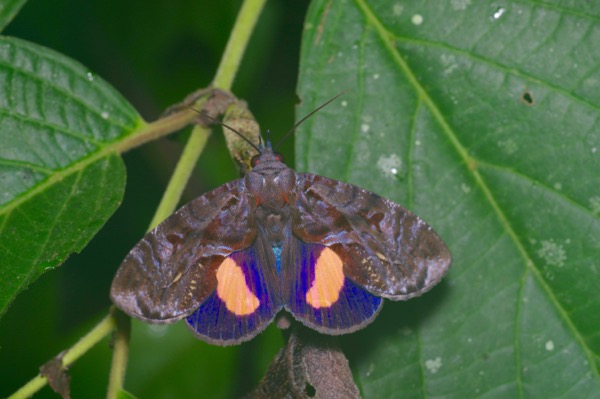
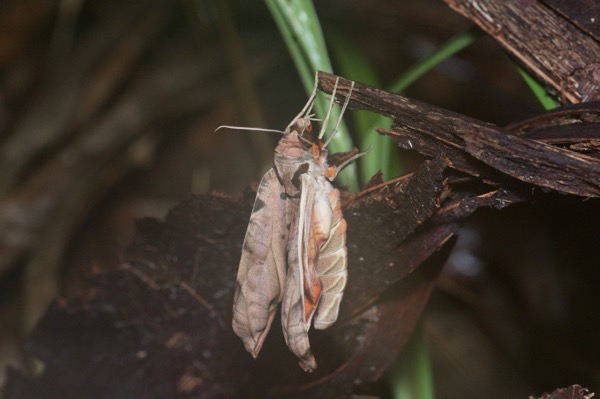
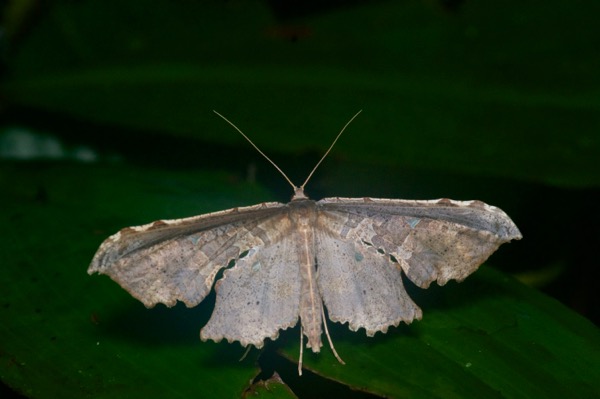
I didn't see a large number of caterpillars, but I did see a few remarkable ones.

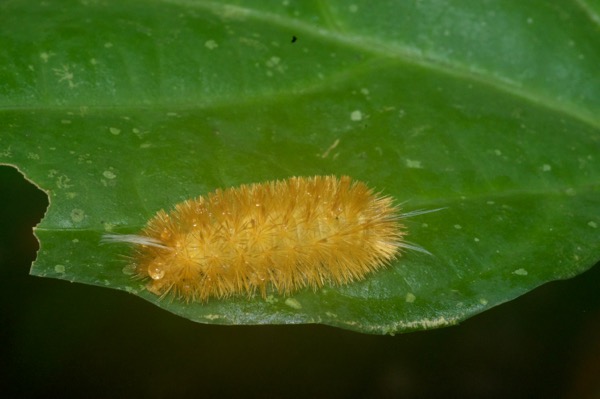
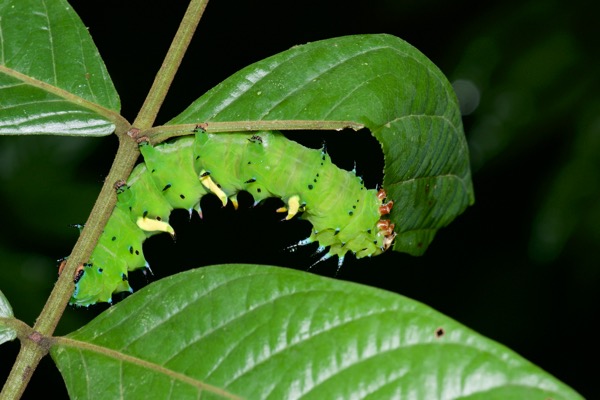
I'm a sucker for phasmids, and once again Santa Cruz did not disappoint. I will try not to bore you too much by only including a few.
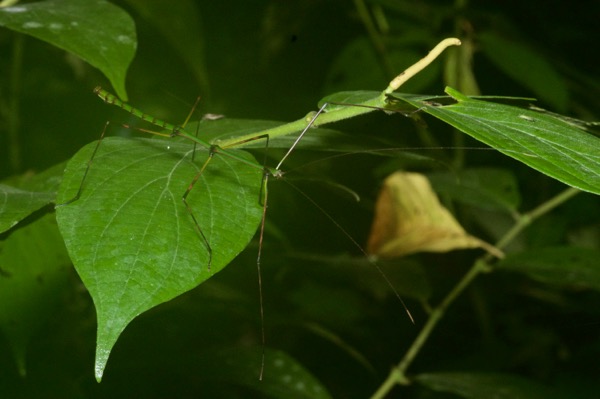
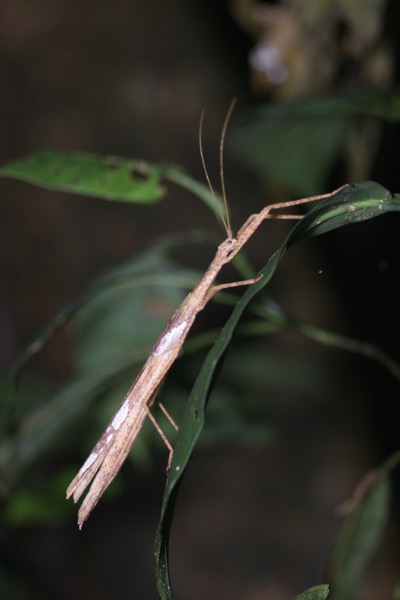
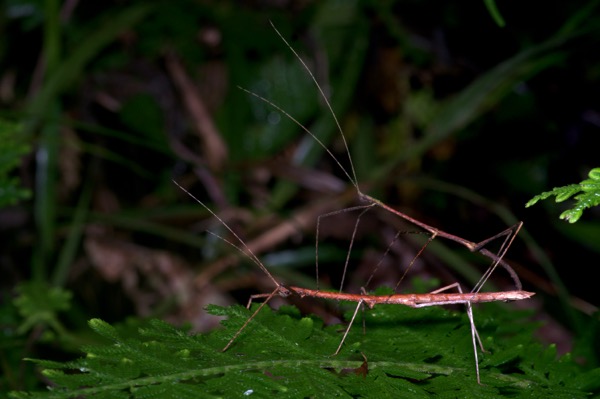
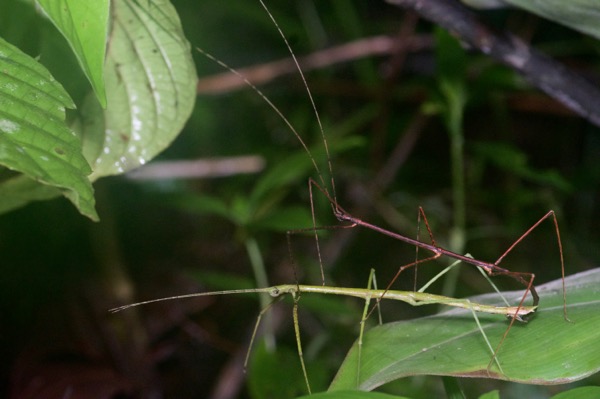
I have seen many a Pleasing Fungus Beetle (family Erotylidae) in Peru and elsewhere, but as far as I know this is my first Handsome Fungus Beetle. I can just imagine a smoky wooden back room in a museum somewhere, probably in Victorian England, with bespectacled and bewhiskered old gentlemen arguing about whose fungus beetles are the most attractive.

This ghostly white weevil seemed to be sporting quite the defiant attitude. I remained unpanicked.
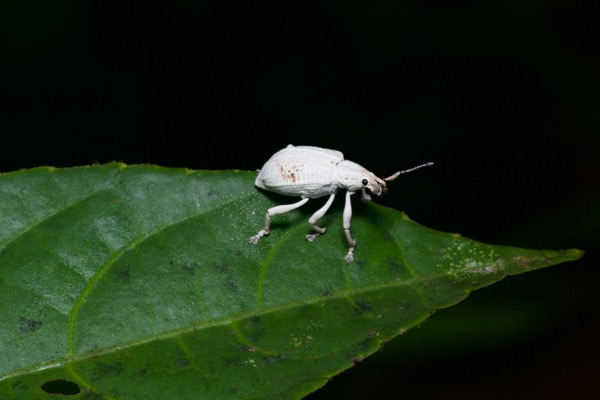
One afternoon while several of us were lounging around at Santa Cruz, Hayley swatted a pesky insect off of her neck and then asked nobody in particular "Are there mantises that look like tiny ants?". Nobody in particular knew (or did not know? I have tangled myself up in grammar) the answer, but we all agreed that the very tiny and dead bug on her hand looked like an ant, and looked like a mantis. We rued its untimely passing for a few minutes, and then Cliff found another one (at which point I must admit we immediately and completely stopped caring about the first one). My lens was fogged at the time, so my photos were bad, but you can get the idea.

Even the "true bugs" are extra colorful and/or weird in Amazonia.

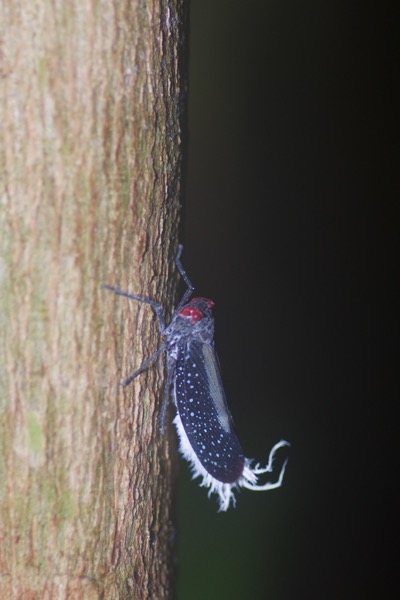
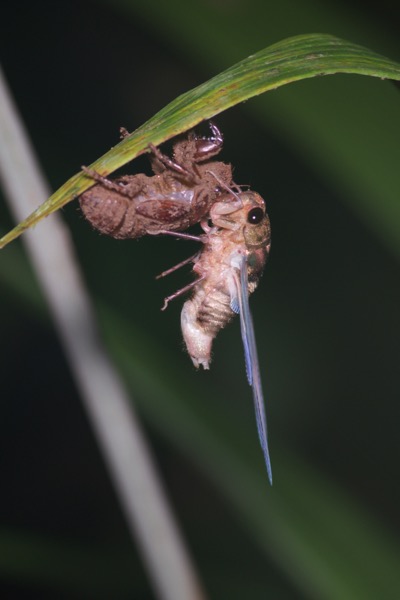
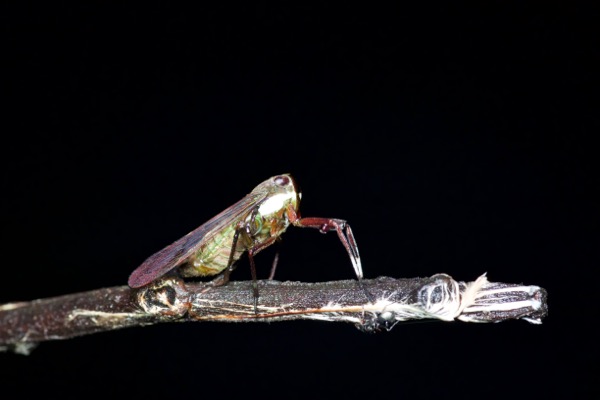
I don't normally take pictures of cockroaches, but I make exceptions for the ones that are several inches long.
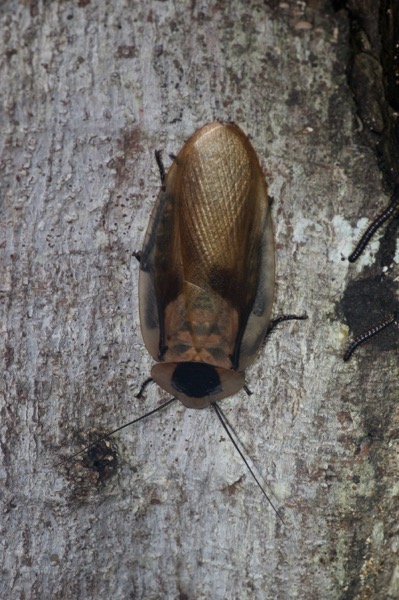
By far the best invertebrate of the trip was this velvet worm, a member of a group of animals so unusual that they have a whole phylum (Onycophora) entirely to themselves. I have seen occasional photos of these in books since I was a kid and never thought that one day I would find one myself. This little guy was maybe an inch and a half long. It did not squirt any sticky, quick-hardening slime from its head, but it could have. Oh, it could have.
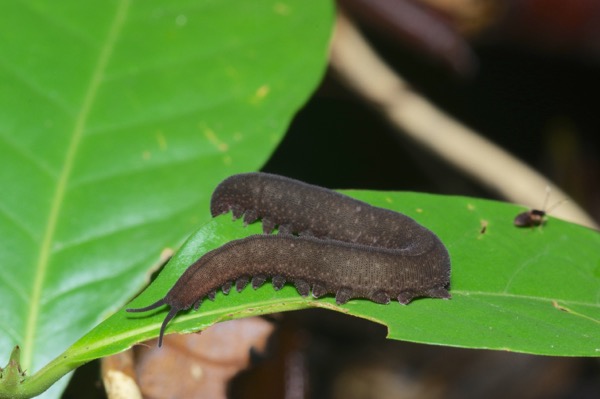
The last of the non-herps that I will subject you to are a couple of ex-insects that have been eaten alive from the inside out by horror-movie-worthy fungi. I had been calling these "Cordyceps fungi" but have since learned that some other related fungi genera could be to blame here.
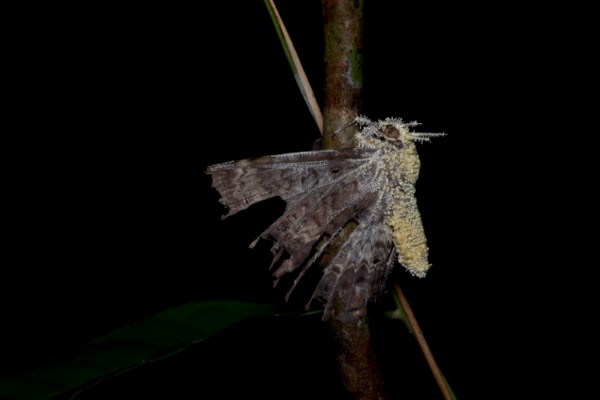
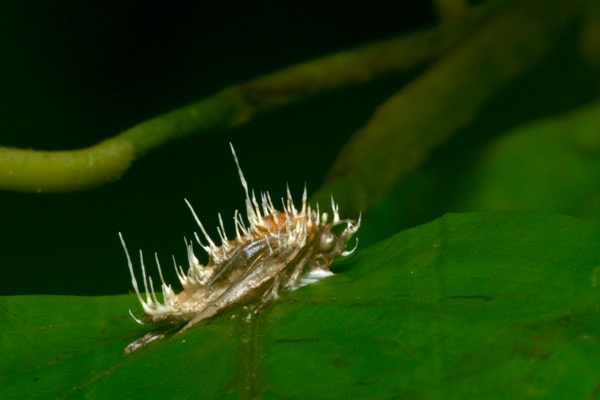
Finally, some herps! Here are a few more variations of the ubiquitous forest toads.
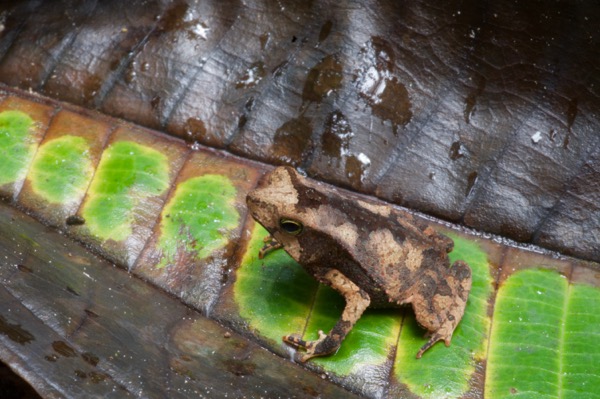
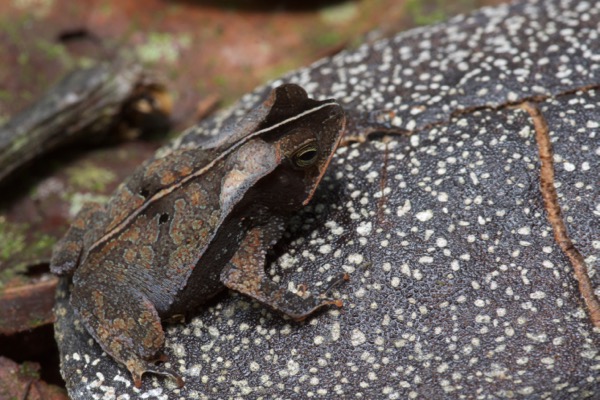
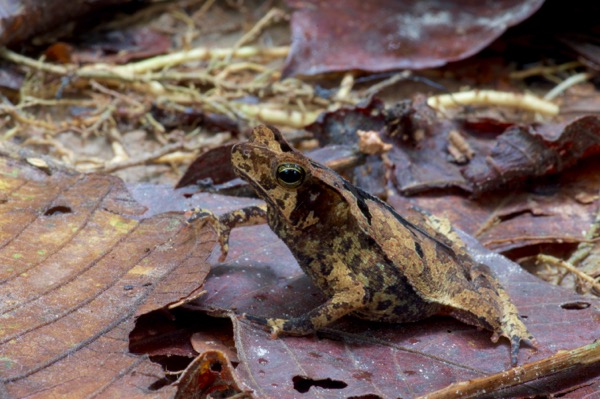
I initially mistook this miniscule toad on the forest floor at night for a metamorph Rhinella "margaritifera", but something about the way it hopped made me take a closer look. The long legs and consistent rough texture identified it as a different Bufonid.
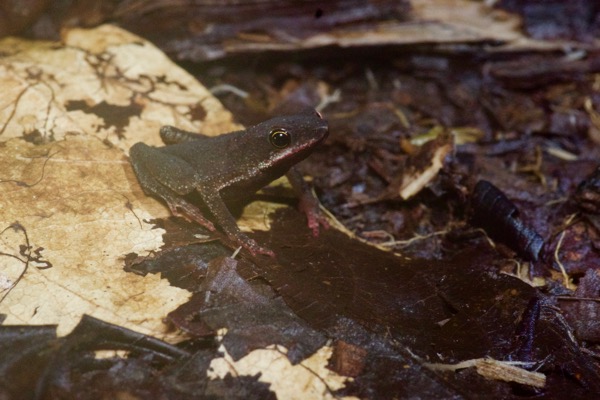
Most of the frog species I've seen at Madre Selva are also present at Santa Cruz, and vice versa. But due to a combination of different terrain, different microhabitats, localized populations, and the luck of the draw I always end up seeing significantly different sets of frogs at the two locations.
I saw five small treefrog species at Santa Cruz this year, none of which I had seen at Madre Selva. The most generically "tree froggy" of these was the Two-striped Treefrog, which is very common in the area but which for whatever reason I didn't see at Madre Selva.
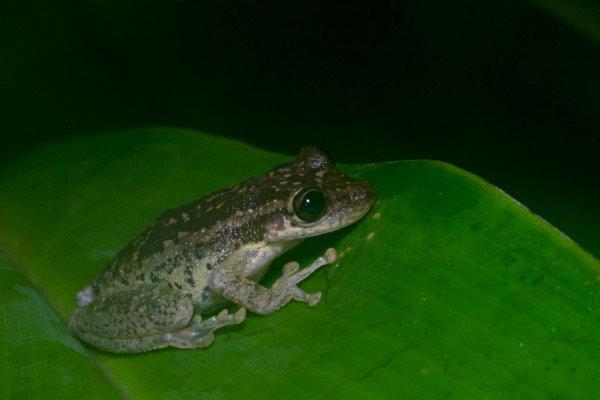
The Polkadot Treefrog is another species that is pretty common at Santa Cruz but rare at Madre Selva, at least in my experience. This is no doubt partly due to the big pond at Santa Cruz, a gathering spot for this species among others, but that can't be the whole story because I've also seen them in the Santa Cruz forest far from the pond. Here's a typical adult:
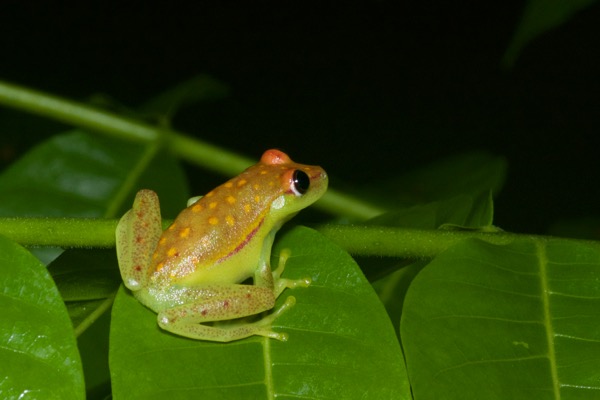
Here's a youngster apparently being menaced by a terrifying stick monster:

I think this metamorph treefrog is another Polkadot Treefrog, but I'm not completely sure. Holler if you have a different idea:
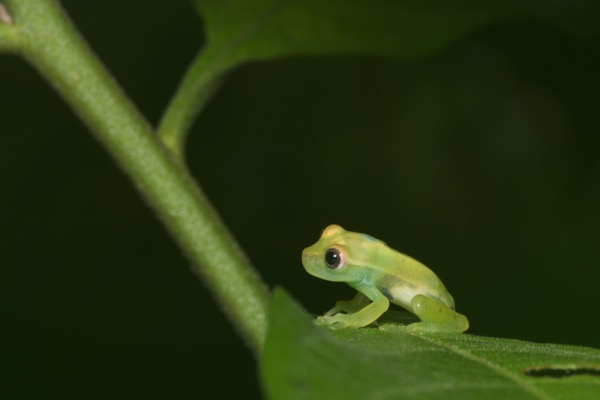
The most numerous frog around the Santa Cruz pond is the Variable Clown Treefrog, another species I didn't see at Madre Selva. Calling males are a common sight.

Pairs in amplexus are not especially rare either.

And sometimes they're just hanging around individually.

At Madre Selva I had seen an Amazon Milk Frog in a tree hole. At Santa Cruz I didn't see any of those, but I did see a few of their cousins, the Common Milk Frogs a.k.a. Veined Milk Frogs.
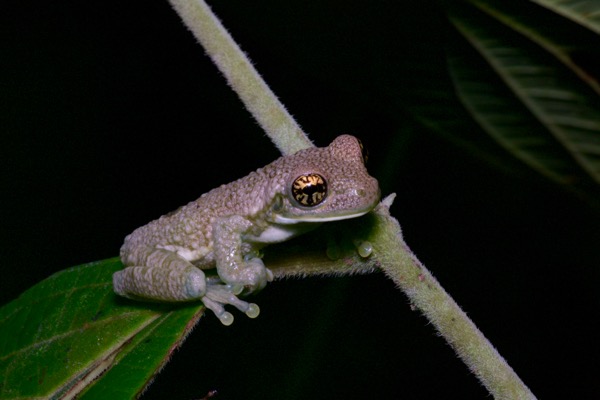
Rough-skinned Green Treefrogs are the last of the small treefrogs that I saw only at Santa Cruz this year. This one that Michael and I found on a long walk through the forest had only one eye, but was full-sized and healthy in appearance.

Here's a larger treefrog that I did see at both locations. Note the horrible nasty mosquito taking advantage of this poor innocent frog. (And don't try to tell me that mosquitos are a normal and necessary part of the natural ecosystem. I refuse to believe it.) Something I love about the tropics is how many extra, unnoticed-at-the-time critters (usually but not always invertebrates) show up on photos.
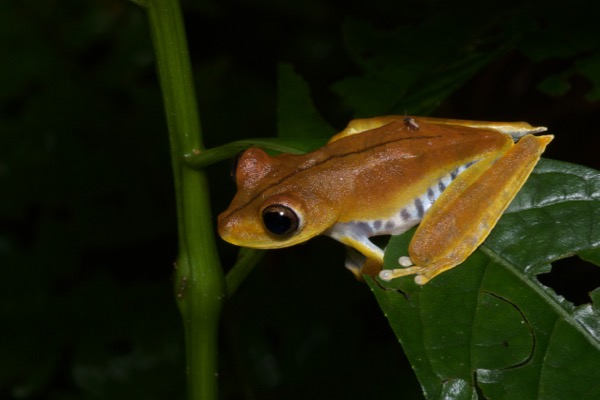
Speaking of mosquitos, how is this frog sitting still and not swiping at its hindlegs?
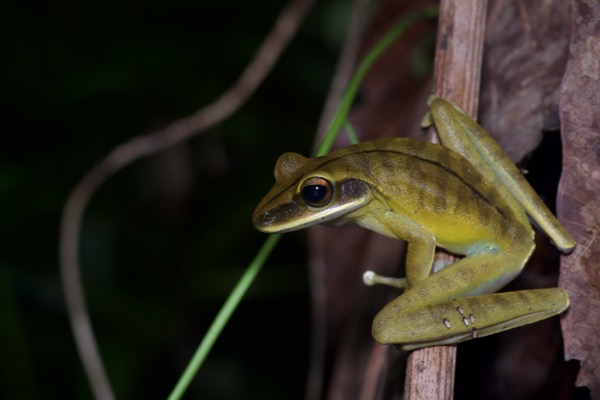
I can't be certain due to the angle, but I believe this is a Yasuni Broad-headed Treefrog.
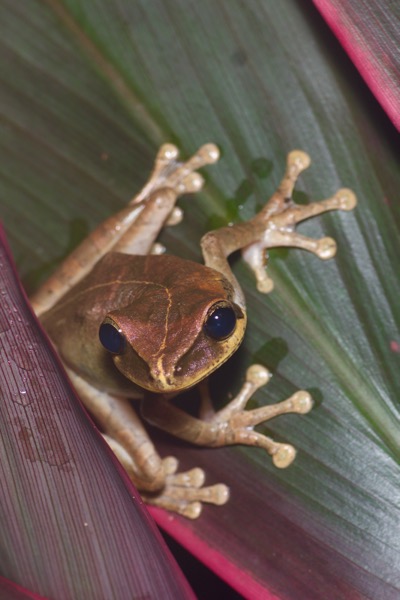
Based on the radial pattern in the iris, the relatively small size, and the pattern, I believe this one is a Mocking Bromeliad Treefrog (Osteocephalus deridens). I love the etymology of this name. I quote from the original species description: "The specific name is the present participle of the Latin deridere (make fun of someone) in allusion to the males' calls from the treetops that sound as if they are laughing at the collectors' vain attempts to reach them."
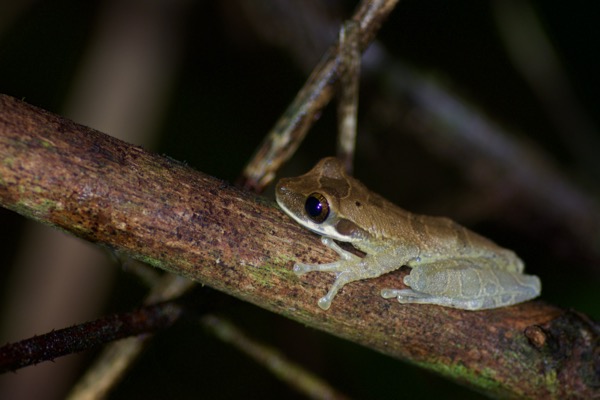
There are a couple of mossy green Osteocephalus species in the area. Based on the amount of wartiness and fringiness, I think the ones I saw were all Buckley's Slender-legged Treefrogs.
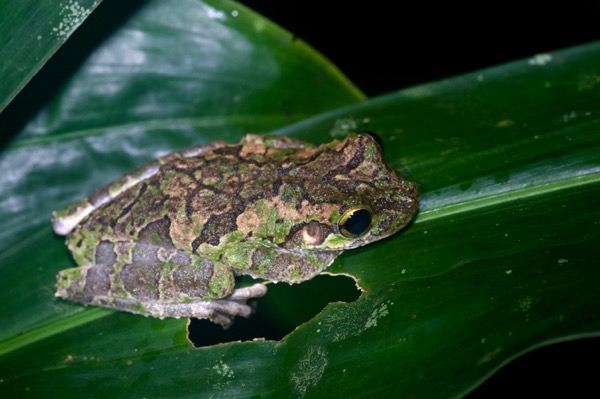

As usual, Giant Monkey Frogs called their distinctive "Bob ... Bob ... Bob" from the trees around the Santa Cruz pond. I saw a few of them there, but they were all high enough up that I didn't take any photos. However, I did photograph a young Giant Monkey Frog on a leaf in the forest, far from the pond.
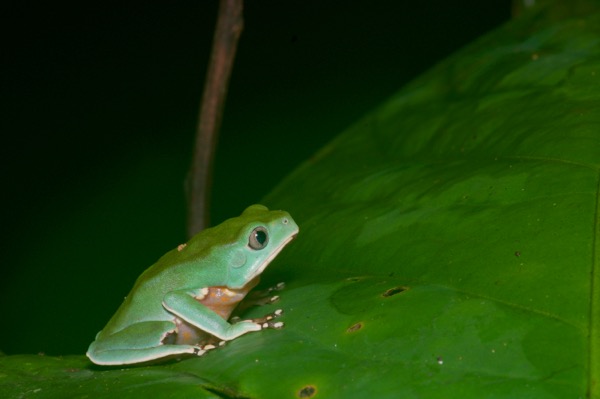
Great big Smoky Jungle Frogs patrolled the area. As always, most flash photographs of these beasts had world-class red-eye.
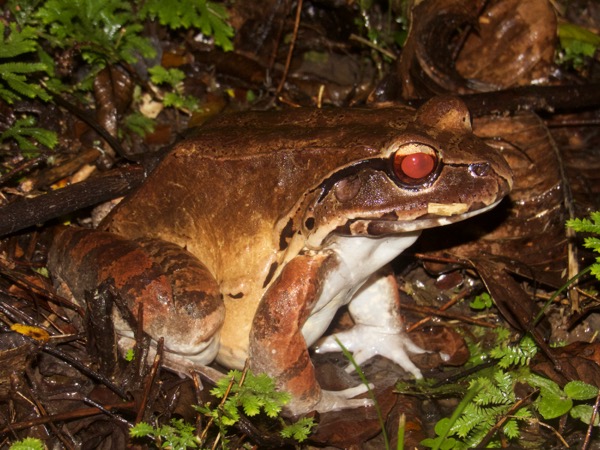
Somehow I managed to get one photo of a Smoky Jungle Frog with normal-looking eyes. I have no idea how I accomplished this.
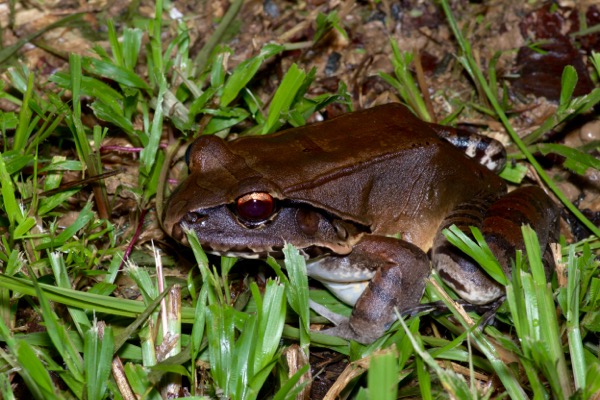
Here's a small Leptodactylus that was hopping about a forest path at night. A number of species in this genus are similar and challenging to differentiate, but I think this is a Dwarf Jungle Frog based in part on the full dorsolateral folds.

I saw fewer species of Pristimantis and fewer individuals in Santa Cruz than I had at Madre Selva. In both places the ones that I saw most frequently were those light-colored little W-marked ones that I was happy to have finally identified (at least hopefully; see the Madre Selva page for the lurid details of this saga).
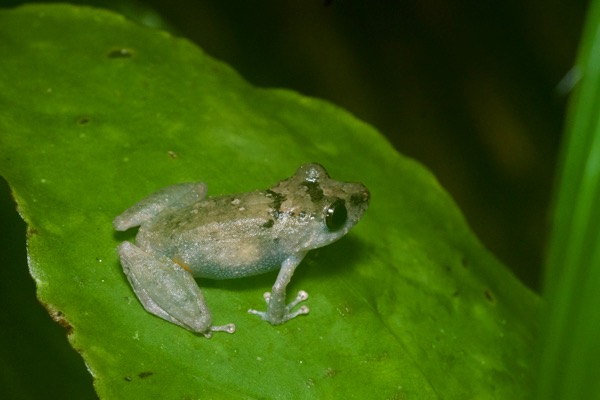
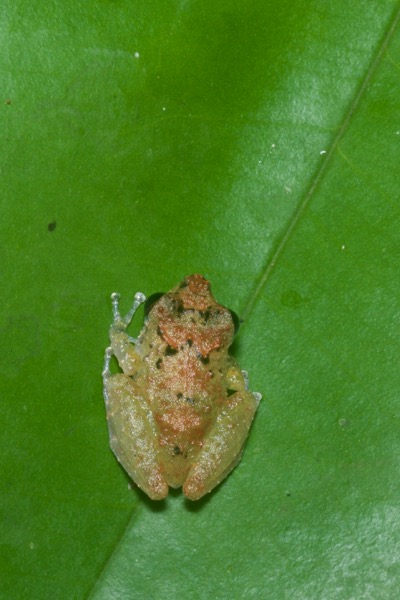
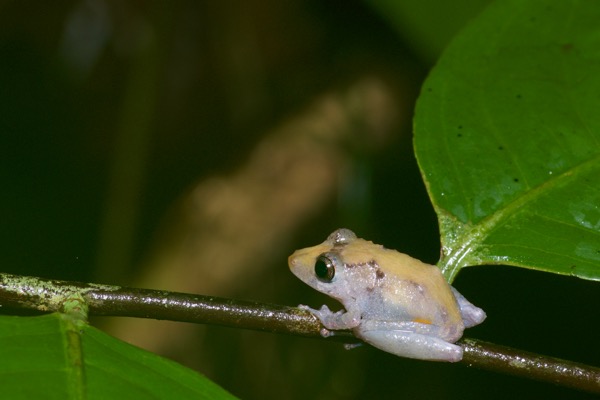
I think this one is an Amazonian Rain Frog, based in part on the bumpiness of the skin, heel color, and eyelid tubercles. But even with an entire book dedicated to this group of frogs in Peru, it's still hard to be certain.
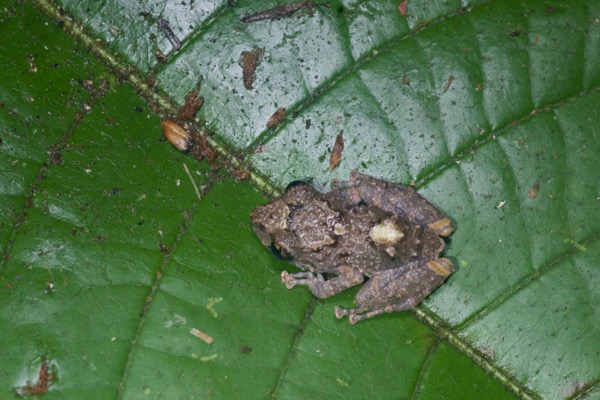
This little guy was at a forest edge rather than deep forest, which means that it is most likely a Cocha Chirping Frog rather than a Forest Chirping Frog.

The Common Big-headed Rain Frog was both big-headed and common; it was the most commonly seen species on the forest floor at night.
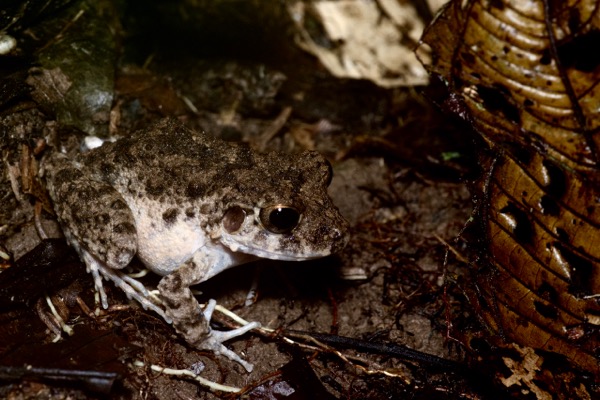
I've never seen as many poison frogs at Santa Cruz as at Madre Selva for some reason. The only ones I saw this year were the two lookalike species that were also relatively common at Madre Selva.

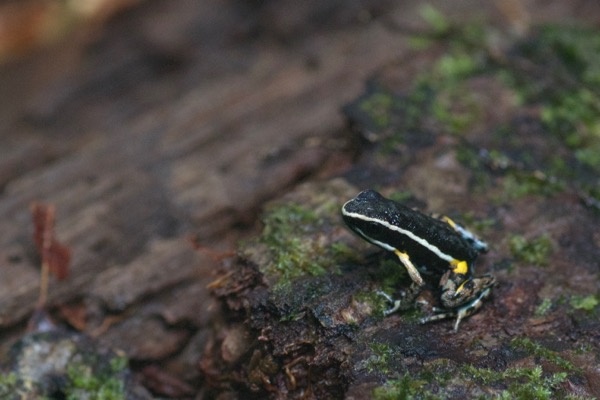
The Santa Cruz pond is home to a few Spectacled Caimans. Usually they make their presence known only at night, when their glowing red eyeshine can be spotted from quite a distance. But on our last morning at Santa Cruz, one big lunk lounged on a log as we prepared our exit from its kingdom. If you look veeeeeeery closely at the photo of the pond at the start of this post, you will notice that I took it that last morning as well.
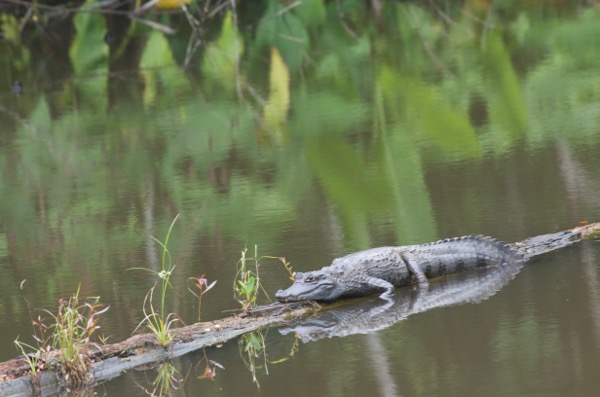
All of the lizards I saw at Santa Cruz were species I had also seen at Madre Selva. I would have to admit that lizards are not the main attraction of Peruvian Amazonia. Frogs and snakes are far more diverse.
After recently visiting Australia, it is hard to believe that this area of Amazonia is the stomping grounds for only a single species of skink.
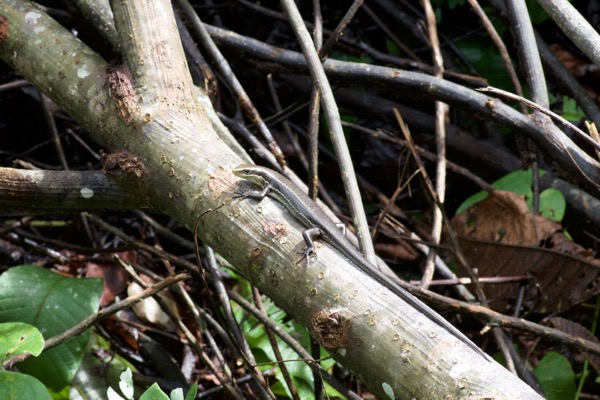
A young Forest Whiptail taking advantage of a small sunny patch in the forest.
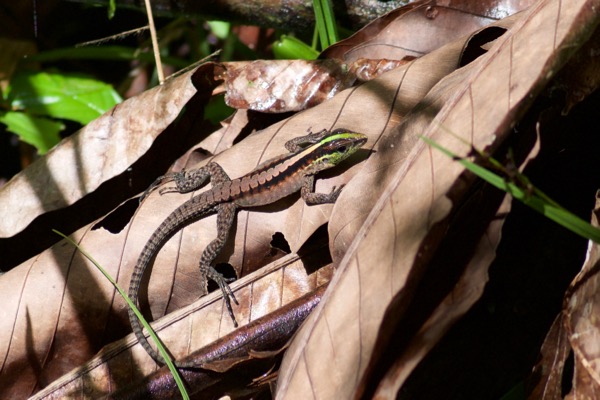
Matt saw several species of microteiids at Santa Cruz, but I managed only one.
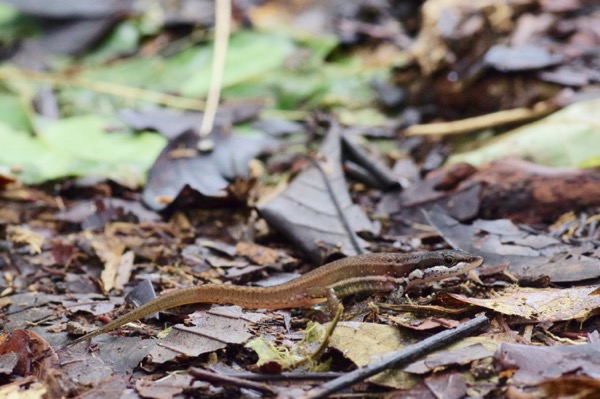
We watched this little lizard for several minutes as it cautiously prowled the nooks and crannies of a bundle of tree roots and the nearby leaf litter. It had a cool tiny black forked tongue with white tips, just visible in this photo.
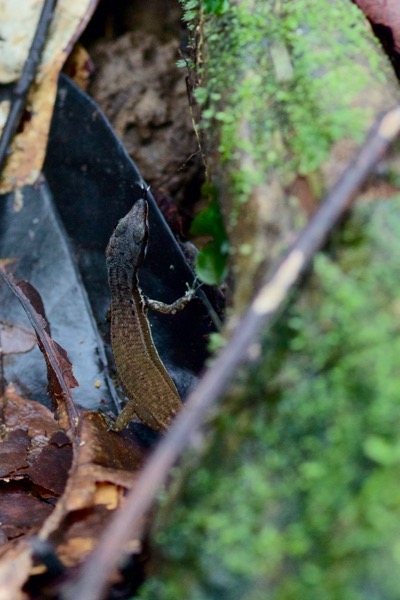
We got brief glimpses of many Gonatodes by day, but they were easier to photograph as they slept on leaves and twigs at night.
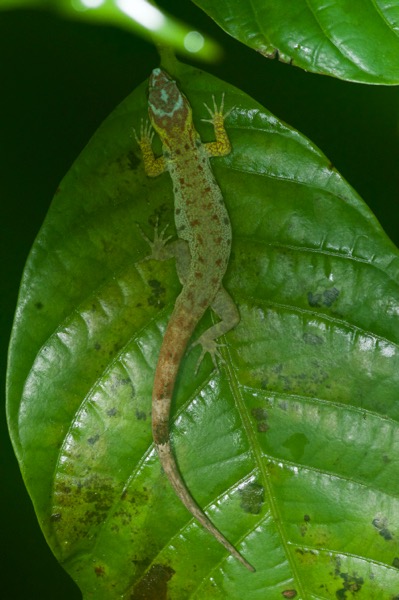
I know Turnip-tailed Geckos do live in the forest because I saw one there once. But all of the many others I've seen have been on buildings.
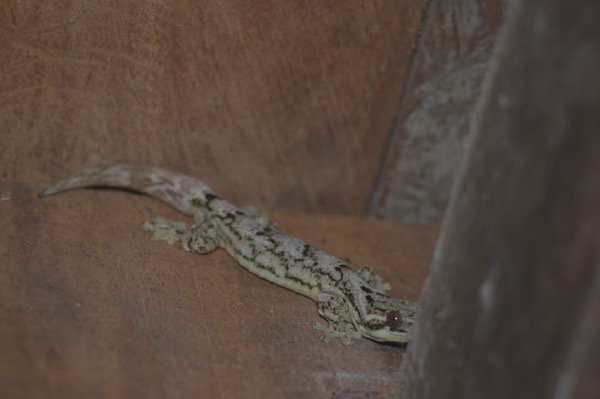
The anole distribution at Santa Cruz and Madre Selva seems to be about the same, though I generally see a few more at Madre Selva. This year I saw three species at Santa Cruz.
Here's a young Common Forest Anole still hauling a few drops of water around after a rainstorm.

And an older one sleeping on a leaf at night.
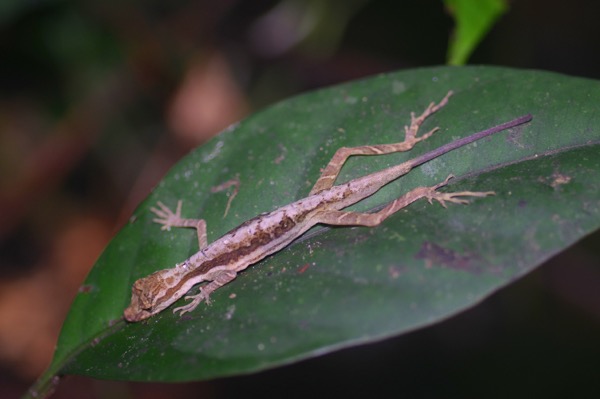
A peaceful Slender Anole (the most nondescript of all Peruvian Amazon anoles), dreaming of not being eaten by arboreal snakes:
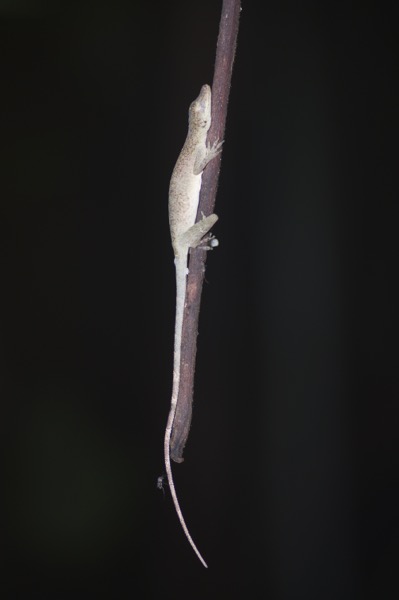
And another, just after becoming aware of our presence:
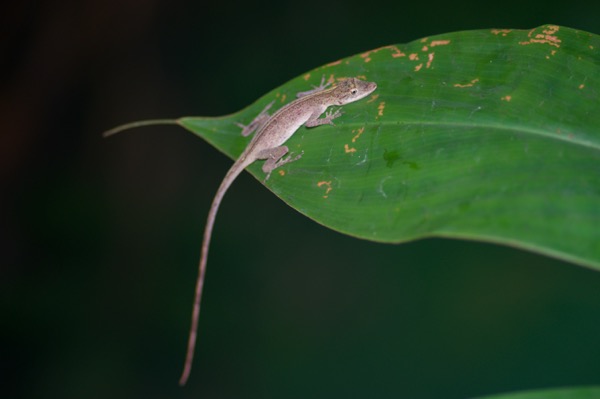
This teeny tiny baby anole was shedding its skin and also very wet from a recent rain. I think it's a Slender Anole but it might be an Amazon Bark Anole.
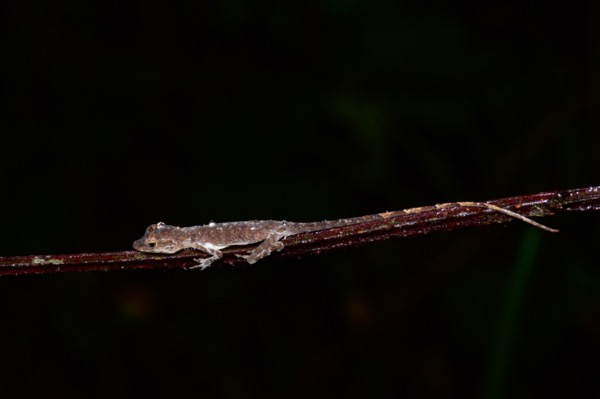
My favorite anoles in the area are the Blue-lipped Forest Anoles, with their cute little pug snouts, and their fantastic leaf-litter camouflage, and their general ease of capture and willingness to sit still for photos. Both of these were found waddling across the forest floor and gently placed on nearby tree roots for photos.
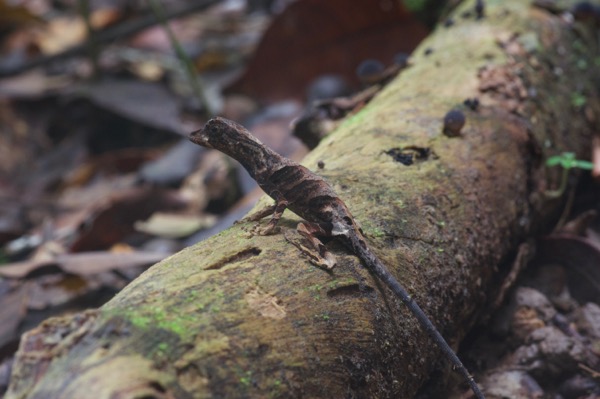
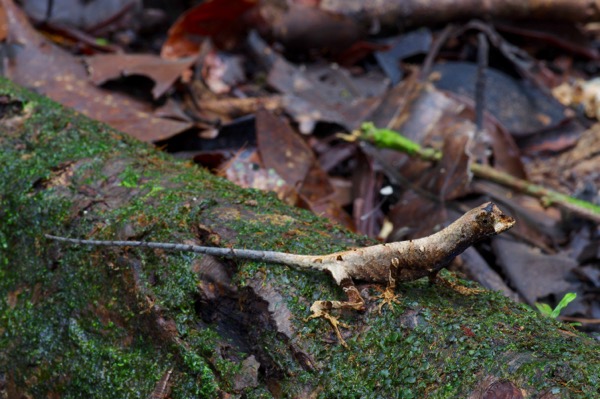
We were all hoping that the main event at Santa Cruz would be the snakes. Our snaking at Madre Selva had been up and down; many nights with one common snake or no snakes at all, but also a night of seven snakes and another night of five. (In Amazonia, on foot, five snakes in a night is a serious haul, and seven is fantastic.) We were hoping that Santa Cruz would provide us with more snakes, and if we were really fortunate perhaps one of the epic tropical snakes.
Bushmasters are seen reasonably often at Santa Cruz, perhaps once every three herp-oriented trips on average. But of course you still have to be lucky. Matt had been to this area eleven times before first seeing one three years ago (unlucky). That same trip was my first visit to the area (lucky). Everyone always wants to see a Bushmaster, but the Bushmasters do not always oblige.
Also high on everyone's wish list, and in the very highest position on some, was the Emerald Tree Boa. Possibly there are places in Amazonia where this gorgeous snake is not difficult to find, but northeastern Peru is not one of such possibly extant places. Lorrie had been coming to this area for something like thirty years and nobody had ever seen one on any of her visits. She had even offered the local guides 100 Soles (about 30 US$) if they could find such a boa.
With thoughts of snakes like these on our minds, we got off of our boat in mid-afternoon and hiked up the mile-long muddy hill to the Santa Cruz field station. After some negotiations about who would be in which tambo with whom, we unpacked our bags a little and gathered together in the common area as dusk approached, anticipating a delicious dinner and our first night hike in this area.
While we were sitting around on our lazy butts discussing our hopes for the upcoming few days, Edvin threw open the door and excitedly let fly Spanish words that we immediately understood: "¡Boa esmeralda!" Everybody leapt up and followed him about 100 feet from the building to the start of the trail, and then another couple hundred feet up the trail. It was by now dark, and Edvin was shining his flashlight up towards the canopy. But he was not aiming at any one spot; he was pointing his light back and forth, and then moving to a different spot on the trail and doing this again. He had seen an Emerald Tree Boa somewhere very near here, and then ran down to the station to tell us, and now he could not find it again! This sounded very, very bad. But we knew Edvin, and we knew not to doubt his snake-finding skills. Within a few minutes he had relocated it, maybe twenty feet up, and soon a dozen flashlights were illuminating it. Soon after that a dozen camera flashes were illuminating it.
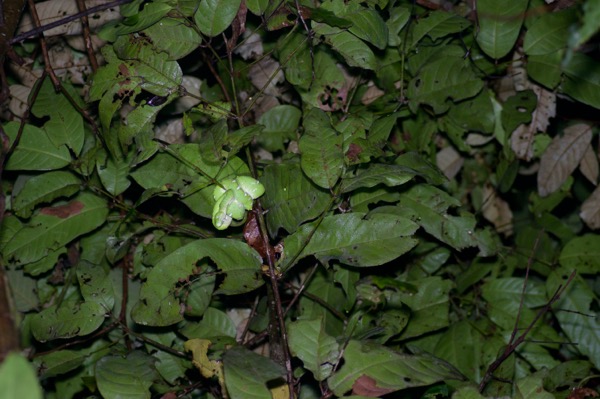

After a hundred or so similarly low quality photos were taken of this distant snake, Edvin realized that the branch it was coiled around grew from a small tree with a trunk only a couple of inches in diameter. He and Cesar (I think it was; perhaps it was Emerson) tried to bend the tree enough to put the snake within reach, but this was slow going and the boa began to wise up and stretch out, looking for another perhaps less bendable support. Ah, no worry. Cesar whipped out his handy machete and with two whacks the trunk was cut through and two seconds later the boa was in someone's hands. The former tree had been right at the edge of the path, so I guess you could consider this a form of trail maintenance.
At the time, we all thought we were photographing the Emerald Tree Boa (Corallus caninus). Only after we returned home did we discover that the species had been split in 2009, and Corallus caninus now refers to a species restricted to the Guiana Shield.
The next afternoon featured hundreds of additional photos of this gorgeous creature perched in various locations closer to the ground. It was released soon thereafter back near where it had been found. Not on the exact same tree, of course.


The dinner conversation that first night was all about the boa we had just seen within a couple of hours of arriving at Santa Cruz. We ate more quickly than usual and split up into groups to see what other wonders the night might hold. Cliff, Matt, and I headed one direction while other groups chose different paths. We had been out for perhaps twenty minutes and seen a few frogs when Cliff aimed his flashlight into a clump of foliage that I had just walked past and said, softly and slowly, something very much like "Hoooooe leeeeee ship". Where he was looking in, a Bushmaster was looking out.
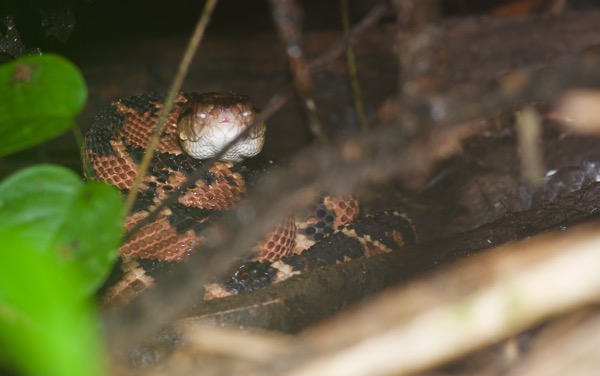
Fortunately, Matt (who had been twenty or thirty feet back, photographing the young Giant Monkey Frog pictured above) was carrying his lucky Bushmaster pillowcase, the same one used to transport the first Bushmaster he and I had seen three years earlier. He was also carrying a pair of tongs, and Cliff had a snake hook, and I found a sturdy stick. Matt wrangled the Bushmaster into the pillowcase while Cliff and I held it open from a distance, and soon we had one very heavy bag o' snake ready to bring back to camp for everyone to ogle and photograph. But heck, we had just started our hike, and didn't want to head back to camp yet. Cliff had a satchel (think "European carry-all") just big enough to hold the snake-laden pillowcase, so in it went, and we continued down the hill with Cliff's load quite a bit heavier but his step quite a bit lighter.
We knew we would soon meet up with Michael and Tom, who had taken the same loop trail but in the opposite direction, so we came up with a plan for how to share our good news. We would start by asking them if they had seen any snakes yet, and ask for details if they had, cooing appropriately for even one of the common species like Imantodes cenchoa. Then we'd wait until they asked us if we had seen any, and we'd say something like "Just one, but we're not quite sure what kind". And then we'd show them a photo.
It almost worked. We ran into them, and asked about their snake luck, and they reported that they hadn't seen any. Then they asked us about our snake luck, and Cliff said we had seen one, but he couldn't maintain enough of a poker face. Tom saw right through Cliff's ship-eating grin and spat out "oh man, you got a Bushmaster, didn't you!"
The next day it was trotted out for photos, and was also measured and had a scale clipped for a DNA sample at the request of Kenny Wray, a biologist who had been doing field research at Santa Cruz for about six months. Here's what the Bushmaster looked like in the light of day:
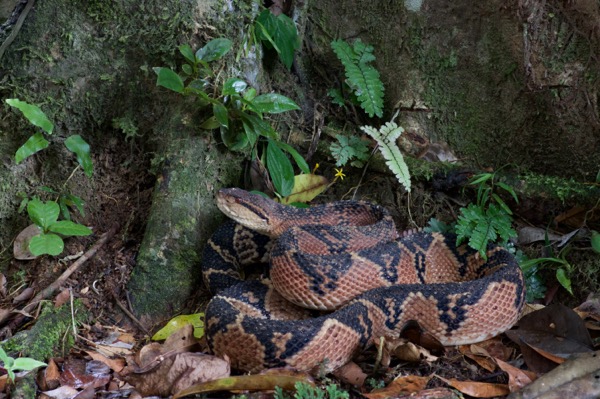
After finding the Bushmaster, Cliff was naturally ecstatic, as it was the snake he had most been hoping to see in Peru. Number two on his wish list was the beautiful arboreal Red Vine snake. The way our snake luck had been going so far in Santa Cruz, none of us were especially surprised when Cliff soon spotted one of these snakes at his feet, crawling across a wooden bridge. I didn't get any in situ photos of this one, but here are a couple of photos from the next afternoon:
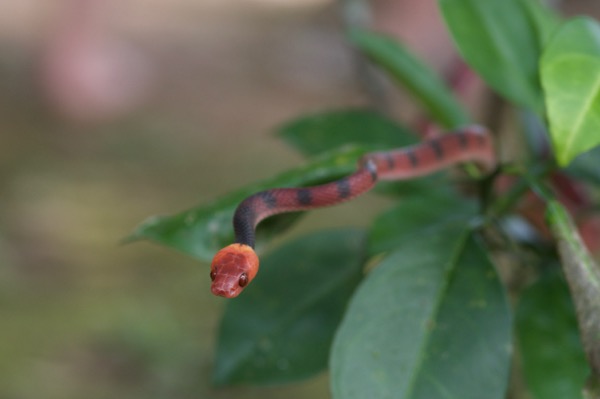

We didn't see any other snakes that evening, and if I recall correctly none of the other groups did either.
The next morning I tagged along with Edvin, Raul the caretaker (not to be confused with Raul the cook), and Emerson. Emerson and I were chatting about this and that and had fallen behind Edvin and Raul by maybe 100 feet when Edvin yelled something in Spanish back at Emerson. Emerson yelled back to Edvin and told me "let's go!" and we both ran up the trail. When we caught up, we came upon Edvin holding the tail of a massive snake, trying to prevent it from escaping while also trying to prevent it from curling back and biting him. Emerson had been carrying a stick with a slightly forked tip that he had fashioned earlier on the hike and he jumped in to help. Raul was standing a few feet away with a bemused look on his face. I asked Emerson if I could help but he said they had it under control. So I pulled out my iPhone and recorded the events for posterity.
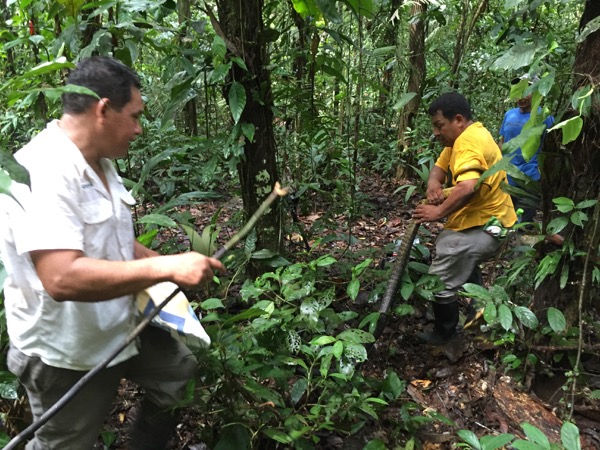
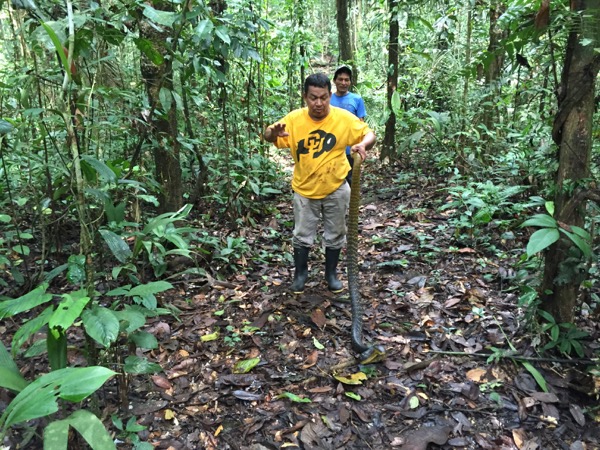



After posterity seemed sufficiently satisfied, the snake was lowered carefully into the pillowcase, which was tied up and placed in Emerson's backpack. High fives were exchanged all around before we hiked back to the camp to photograph and measure our new acquaintance, eight feet and five inches of glorious Cribo, a.k.a. Yellow-tailed Indigo Snake. It was actually pretty cooperative for photos and handling by those who wanted to hold it. I think Matt was only bitten once, which is pretty good. This was certainly the biggest colubrid I have ever seen in the wild, and only a couple of Australian pythons away from being the biggest snake.

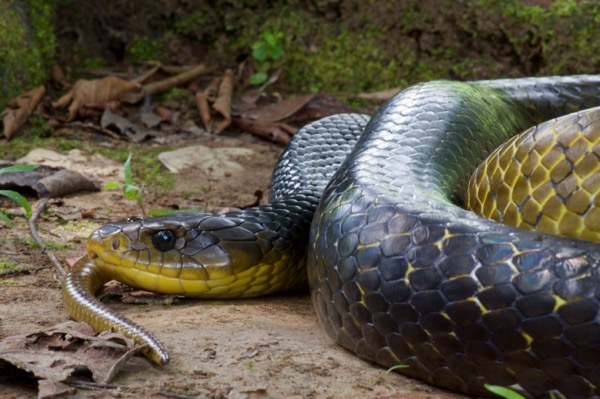
So in our first 18 hours at Santa Cruz we had found an Emerald Tree Boa, a Bushmaster, and a gigantic Cribo, not even counting the beautiful Red Vine snake. We collectively agreed that if we saw no more snakes in our remaining days here, we would be more than satisfied.
For a while it seemed like that might turn out to be the case. On our second night, a heavy rain discouraged us from hiking until quite a bit later than usual. I didn't see any snakes that night, and I don't think anyone else did either. The next day was Super Bowl Sunday. Nobody saw any snakes during the day, and about half the herpers decided to hang around the clearing where a weak cell data signal could be used to intermittently track the progress of the game. I went out with Michael and we saw some frogs and invertebrates, but no snakes. On the fourth day in the morning there were again no snake sightings.
The evening of the fourth day picked up a little snake-wise. Matt and Tom found another Red Vine Snake, and Cliff found an Amazon Scarlet Snake (Pseudoboa coronata), like the one we had seen on the Nauta road in Iquitos but larger. Neither of these snakes were interested in having their photos taken. Later Cliff and I were poking around a stream looking unsuccessfully for rumored glass frogs when he came across a sleeping Ornate Snail-eating Snake:
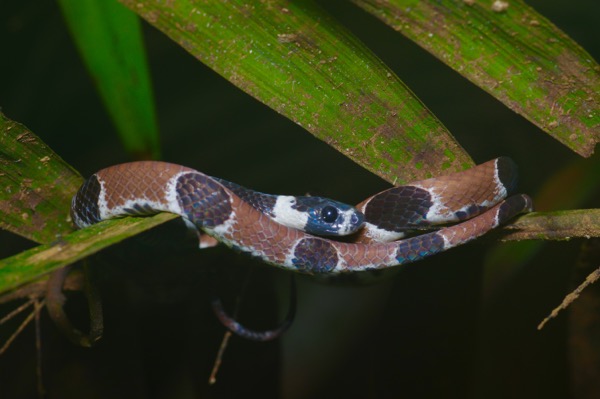
The next day was our final one in Amazonia. Matt, Joe, Cliff and I took a long hike in the morning. We saw dart frogs and some fine lizards and some lekking birds and even a troop of monkeys, but no snakes. Then in mid-afternoon the rain started, and quickly grew heavier, until soon we were all sitting around in the main building listening to a powerful tropical rainstorm pummel the roof. This soaking dampened our collective mood, as we had hoped for one last good snake night but experience had taught us not to expect much after strong rain.
When the rain had changed from a downpour into a drizzle I got restless and decided to look around the pond and then hike into the forest on a small trail that I hadn't previously noticed. Soon the rain had essentially stopped, and I quickly came across a very wet Green-striped Vine Snake coiled at about my eye level.
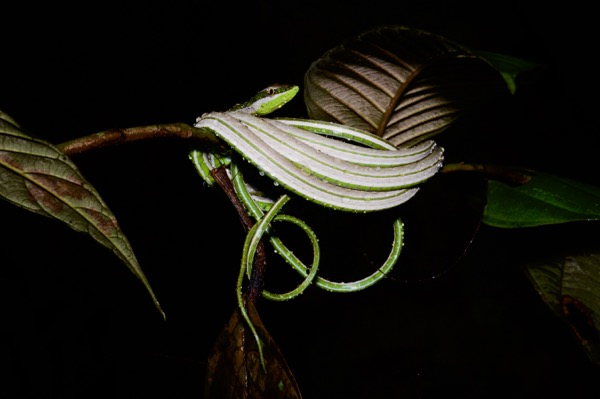
This was a nice start to the night, and I knew others would want to photograph it the following morning before we headed back to so-called civilization, so I gently encouraged it to unwrap itself and come along with me. I had a couple of big ziploc bags with me but no cloth bags, and I didn't want the poor snake to endure a potentially longish hike in a plastic bag, so I brought it back to the field station right away. Joe, Ben, Hayley, and Ryan were hanging around there, so I put the snake in their care and headed back the way I had come.
I had just crossed the little dam across the pond when a movement in the leaf litter caught my eye. It took me half a second to recognize it as a snake, and another half a second to recognize that the shape was neither viper nor coral snake. It looked like a generic colubrid such as a garter snake, until I covered it with my hand, whereupon it immediately flattened its body and basically went stiff. I gave it some time to unflatten, but it had its mind made up.
I still didn't have a cloth bag, but this time I was even closer to the field station buildings, so I brought it back and once again handed it over to Joe, Ben, and Hayley, who were a little surprised to see me bring them a snake for the second time in about ten minutes. (Ryan was busy flirting with the young daughter of the caretaker so he didn't count.) We quickly determined that it was the species that Dick Bartlett's field guide called "Flat-headed Snake", though I wasn't too impressed with this name since the head was really the only part of the snake that was not extremely flat. The Internet mostly uses the English name "Wucherer's Ground Snake".
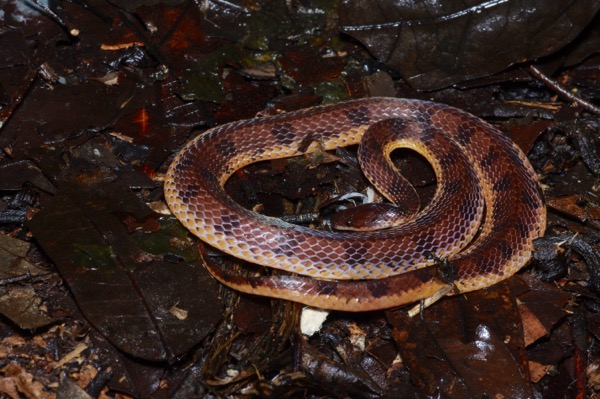
Out I went for a third time, off in the same direction. It seemed to be a good direction. I headed up the previously-unnoticed trail mentioned earlier, and soon noticed a Blunt-headed Tree Snake that was not yet out on its nighttime hunt. Since this was the most commonly seen snake in the area, I let it be and continued. Three snakes in about thirty minutes. I guess the earlier downpour wasn't such a bad omen for snakes after all.

I continued up the unknown trail until I saw a building and some dim lights and heard some dim voices in the distance. I guess the trail was leading out of the preserve and into a nearby village house, but I'm not sure. I didn't want to trespass so I turned around and headed back the way I had come. As I was getting close to the back of the pond I saw lights and heard voices in front of me. Was I on some crazy time-space Möbius strip? It turns out that this was not the case; I was coming up on Ben, Hayley, and Ryan on the trail. And what were they doing on the trail, you might ask? Glad you asked. They were keeping an eye on a snake, hoping someone would happen along that could help Ben capture it. The kids were not allowed to help because the snake was, you probably guessed it, another Bushmaster.
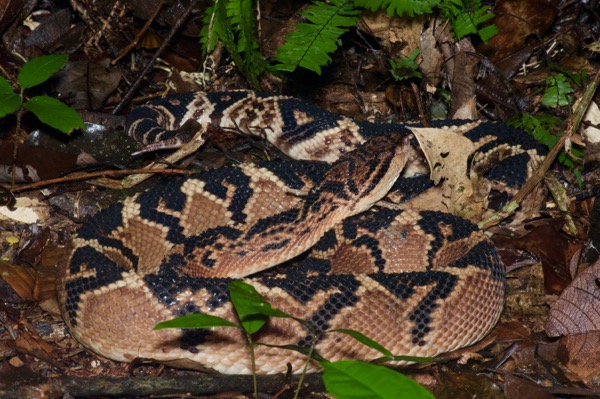
Ben had already gathered a couple of pairs of tongs, and a big tub in which we had held the previous Bushmaster, and rope with which to tie it shut. The two of us used the tongs to grasp the snake by the neck and body and lift it into the tub, and then we got the lid on, and then tied the tub shut. We brought it back to the field station to join the Green-striped Vine Snake and the Flat-headed Snake for the next morning's final photo shoot.
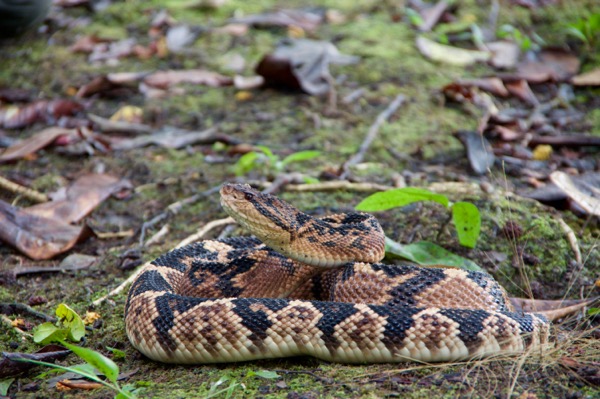
In the thirty-plus years of MT Amazon Expeditions (formerly Margarita Tours) bringing groups to this area, this was the first time two Bushmasters had been found on the same trip. An outstanding finale to another wonderful visit to Peruvian Amazonia.
John